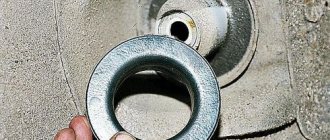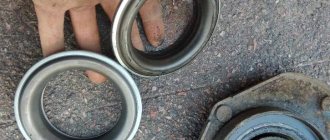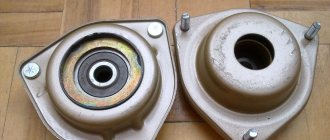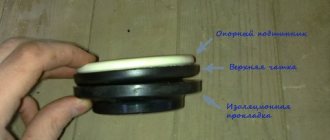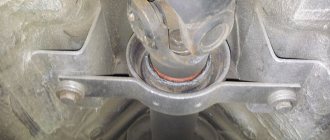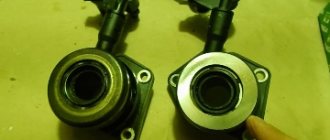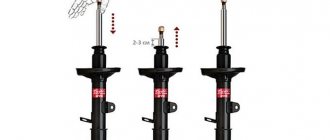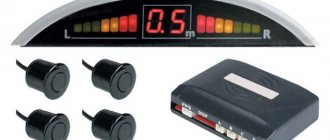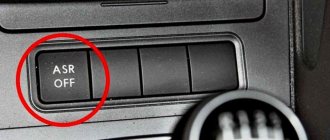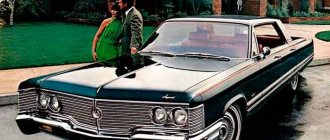If parts in the front suspension of a car malfunction, various squeaks, knocks, clicks and rattles occur while driving. It is clear that this is not just like that. The suspension desperately signals that a diagnosis needs to be carried out, and the sooner the better.
There are not so many parts in the front suspension that even a simple external inspection cannot detect a malfunction. To do this, it is not necessary to have extensive experience in suspension repair. It is important to be careful here, and most importantly, you need to know the structure of the car well and understand what functions the components and parts of the car perform.
Front suspension
Consider the front suspension of a passenger car. Despite the design features of different types of models, all front suspensions are fundamentally the same. True, not all parts can be part of the suspension.
Since the car has two front wheels, many parts can be paired. Here is an approximate list of what is included in the front suspension:
- Steering knuckles (or axles), right and left;
- Front shock absorbers, right and left (can be symmetrical);
- Front springs (mostly symmetrical, but available right and left on some models);
- Front stabilizer, there is only one;
- Stabilizer struts, there are two of them, are rarely asymmetrical;
- The front suspension arms are almost never symmetrical, but they can be upper and lower, and there is also a multi-link suspension;
- Support bearings are always symmetrical, two bearings, but not available on all models;
- Support cups, boots, spacers, etc.
Support bearing
So, support bearings are not available on all models. Their presence is required where the shock absorber itself or the shock absorber strut rotates together with the steering knuckle. The bearing allows the shock absorber to rotate freely in its upper support, without resistance or unnecessary friction.
The support bearing (OP) is located above the front spring, and the shock absorber rod passes through it. Depending on the design features, it can be prefabricated or a single part, but one way or another, the shock absorber is attached to the front side member of the body.
At its core, the part is a rolling bearing; it has a wide cage. The OP must be durable, as it experiences heavy loads when the front spring operates, especially on rough roads.
Support bearing faults
What are the signs of a faulty support bearing:
- when the car is moving, a knocking sound is heard in the area of the right or left front side member of the body, it is especially noticeable when turning and on uneven roads;
- The car has become less controllable and does not immediately respond to turning the steering wheel.
For what reasons can the front bearing fail:
- Poor road conditions;
- Very harsh driving style;
- Factory defects, low quality parts;
- Natural wear of bearings during long-term operation.
It should be noted that support bearings cannot be repaired; a faulty bearing must only be replaced. There can be no talk of any repairs. But the details can be prevented. You can remove the protective cover from the bearing race and treat the inside of the race with lithium grease. Of course, such an operation must be carried out on a working OP.
Replacing a bearing with a separate element
If the support itself is in order, and the fault concerns only the bearing, it can be replaced separately. To do this, remove the rack with the support (the process is described above) and deal with it separately.
Having disassembled the support (the design is different for everyone, but the principle is approximately the same), we inspect the bearing. As a rule, the balls are worn unevenly, there are burrs on the holder, and the seals are damaged.
It is possible that the problem can be solved with little blood
Although journal bearings can usually be disassembled and individual components can be accessed, there is no point in repairing them.
It is hardly profitable to tinker with the component parts of the support bearing, trying to repair them
Firstly, the bearing itself separately from the support is not that expensive.
Secondly, this is a critical unit, so replacing balls or seals using a makeshift method will not lead to anything good. Therefore, it is a clear replacement.
It is safest to replace the entire bearing
Whether to change bearings in pairs or not - there is no consensus. Typically, paired replacements are made more due to reinsurance. Experienced service station workers determine this need based on the general condition of the car’s suspension. It also happens that it is not practical to change the second bearing - why throw away a well-functioning part?
How to carry out work on an Opel Astra (video)
How to determine if a support bearing is faulty
It is very simple to determine the malfunction of the OP. You need to open the hood, grab the shock absorber strut with your hand where it is attached to the body and swing it sharply from side to side. If there is play in the bearing or it has crumbled, the strut will move with characteristic clicks. You can do the opposite - grab the wing and rock the car sideways. Then, if the OP is faulty, the body will move, but the stand will remain almost motionless. All movements must be accompanied by knocking in the area of the defect.
Replacing the support bearing
To replace the OP you will need a jack, automotive tools and spring ties. Disassembly order:
- Loosen the wheel nuts.
- We put a jack and lift the car with a jack (you need to be on the safe side - put jack stands under the rear wheel)
- We remove the wheel.
- We disconnect the brake caliper and move it to the side; there is no need to disconnect the brake hose.
- We release the steering knuckle from the bottom from the lever and stabilizer bar.
- We unscrew the fastening of the shock absorber strut to the side member from above and remove the shock absorber with the spring and steering knuckle - the entire structure is assembled.
- We tighten the springs with zip ties and disassemble the shock absorber strut.
- We change the support bearing and reassemble everything in the reverse order.
There is one clever way in which zip ties are not required to replace the OP. While the wheel is not removed, you must first disconnect the nut securing the shock absorber rod. But to replace with a similar method, it would not hurt to have a little experience in repairing the chassis of cars.
In general, the job of replacing a thrust bearing is not very difficult; only normal hands and tools are required.
To avoid serious damage to car systems, you should pay attention to the slightest knock or creaking noise under the hood. If you stubbornly ignore seemingly minor signs of malfunction, then serious problems cannot be avoided. In particular, this is a knocking sound when turning the steering wheel. It may indicate a faulty front strut upper support bearing. Changing the support itself is quite simple, and this process will not be accompanied by serious costs. But if you do not pay attention to the breakdown in time, it will lead to more serious consequences.
Device
Let's first analyze its device.
Here is a picture of a thrust bearing. In its upper part there are three studs for its fastening and one central fastening through the inside of the support.
This video was created to explain the essence of installing a support bearing, the purpose of which for some reason most car enthusiasts forget. They only know the purpose of shock absorbers and springs, although the support is an equally important element in the car’s suspension.
Video
Struct assembly diagram for Kalina car
Scheme for assembling struts for Granta vehicles
The video above (see pictures) shows:
• Attaching the upper part of the rack to the body mudguard;
• The stand itself is disassembled with a spring and upper support;
• Support bearing (there are several types).
The upper support serves to smooth out the loads coming from the wheels through the shock absorber onto the car body and distribute them evenly.
Support bearing wear
As it is used, the support bearing wears out and there is grinding, creaking, knocking, and the most dangerous thing is when play appears. All this is reflected in the condition of the rack itself and the entire wheel assembly.
So, if you lift the car on a lift and move the wheel sideways, right/left, you will notice a large free play of the entire assembly, which will tell us that the support bearing requires replacement.
If you look from above, where the shock absorber rod is attached, you will notice its movement from side to side. You can also place your hand on the top of the shock absorber where the rod nut is located. In this place the play is clearly felt.
When the bearing balls wear out, the load on the front suspension elements increases and the vehicle's handling deteriorates. Consequently, all this negatively affects overall traffic safety.
Replacing the rack support
To replace the support bearing, the strut must be removed from the car, disassembled, after compressing the spring with special ties. The faulty support is removed, a new one is installed, the rod fastening nut is tightened, the ties are removed and the stand is installed on the car.
After replacing the supports, it is recommended to check the wheel alignment on a stand to check the wheel alignment angles.
That's all, write comments. Goodbye!
In this article we will get acquainted with a small but very important component of a car's suspension - this is the front strut support bearing (in common parlance, a support bearing).
Let's try to find out why it is needed, what threatens it, and how to determine that a part requires replacement.
There is not a single unnecessary part in the machine, so if at least one of them fails, this can pose a threat to its overall performance. As a rule, a harbinger of malfunctions can be:
- changes in vehicle behavior;
- the appearance of extraneous sounds and knocks;
- unusual vibrations.
Function of front strut support bearings
As the name suggests, the part performs a supporting function. It is the connecting element between the front hydraulic shock absorber strut and the vehicle body. This is a version of a rolling bearing. The part is subject to significant axial loads, which is why it is made of high-strength alloys. And under the road conditions in which modern cars have to travel, the part wears out much faster than we would like. Therefore, it should be checked every 20 thousand km. mileage The worse the quality of the roads you drive on, the more often you need to check it.
To make it clearer where exactly the part is located and what function it performs, you need to remember how the front suspension of the car is designed. For example, let's take a VAZ-2110 car. It has an independent suspension with hydraulic struts. Most modern cars are equipped with the same. The design of the front strut effectively dampens vibrations that occur when the shock absorber spring moves.
Here, special attention should be paid to securing the rack itself. At the bottom it connects to the rotary cam. And at the top – directly with the body. The movable mount is provided by the front strut bearing.
Repair of shock absorber strut support
If it turns out that the bearing is in order, and the cause of the knocking lies in the wear of the damper or other element that is not a critical component of the structure, the support can be repaired.
How to restore a bearing: reconstruction of the pillow on video
In this case, we see a working rubber cushion, which simply changed size during use. Shrinkage can be compensated for by installing a machine-made gasket.
It will not be possible to return the support to 100% performance, but you will ensure a mileage of several thousand kilometers, and without any visible problems in comfort and safety.
Despite the fact that the shock absorber strut support is a critical component, its functionality can be restored without contacting service. Depending on the severity of the damage, you choose between installing a new unit, replacing worn components, or repairing it. The decision depends on your qualifications and the cost of components.
Discount on order amount
| 3% | from 3000 rub. |
| 5% | from 9000 rub. |
| 7% | from 18,000 rub. |
| 10% | from 20,000 rub. |
| 12% | from 30,000 rub. |
| 15% | from 40,000 rub. |
- Add item to cart
- When placing your order, please indicate which store you would like to pick it up from.
- To clarify the list of ordered goods and delivery times, the administrator will contact you
- Payment for goods upon receipt
- Delivery to the store is free
Discount on order amount
Types of support bearings
There are several most popular types of bearings used in modern cars. These include:
- bearing with built-in ring. This arrangement of the front strut support bearing is considered the most convenient to install. The built-in ring can be external or internal. The main feature of this type of bearings is the presence of special holes for installation. Its installation does not require the use of clamping flanges. The bearing ensures the rotation of parts using both the inner and outer rings;
- with outer detachable ring. The inner ring provides connection to the vehicle body;
- with detachable inner ring;
- single divided. This type of bearing is practically no different from all others, but its peculiarity is that it is made of more durable materials.
Factors influencing the price of the service - replacing the front strut cups in Khabarovsk
It is common knowledge that the cost of car repairs depends on several aspects. Among them are the following:
- cost of spare parts (original, China, alternative manufacturers);
- personnel qualifications;
- level of equipment of the service station (availability of painting booths, lifts, special tools and equipment, etc.).
For example, the price of the service - replacing the front strut cups in Khabarovsk will also depend on factors such as the age, make and model of the car. We are confident that car services will compete for your order and offer the best conditions. The centers have a system of discounts for regular customers.
Causes of bearing failures
As is the case with increased wear of other car parts, the support bearing often fails due to domestic off-road conditions. First of all, there are a large number of holes and potholes. The support is subjected to greater loads than it can withstand. That is why, when driving frequently on bad roads, the part needs systematic diagnostics.
Another reason is dirt getting inside the bearing. Its design does not provide any protection, therefore it is open to contaminants entering under the car body from the outside. Again, the quality of the road surface also contributes to this.
Low quality characteristics of new components are a common situation in our automotive parts market. Therefore, one should not be surprised that the support rod lasted half as long as the manufacturer promises.
What are the functions of shock absorbers and upper mounts?
All tasks assigned to the main parts of a car’s suspension can be divided into two categories: those responsible for the safety of the driver and passengers and those providing comfort while driving.
So, when talking about safety, we first of all mean reliable contact of the wheels with the road: minimizing vertical swaying, “jumping” on holes and potholes, and dangerous deviations of the trajectory when turning. Thus, shock absorbers and upper supports create reliable grip on the road surface and allow the wheel to go around the obstacle as efficiently as possible, and then quickly and quietly return to its original position.
At the same time, they help to increase comfort while driving: it is thanks to their “softening” effect that we do not feel all the unevenness of the road, and are also spared the constant shaking and annoying rattling of car parts.
Signs of a faulty front strut support bearings
The most typical sign of support bearing wear is a knocking sound when turning the steering wheel, as well as when overcoming minor obstacles on the road. Significant wear and tear may cause problems with vehicle handling. Its driving performance is impaired, maneuverability and steering are lost.
Due to wear of the bearing, the alignment may be disrupted. When hitting a hole, the part may break completely. In addition, the strut sometimes pierces the body of the car, and this requires more significant costs than the usual replacement of the strut. Then you will have to straighten and paint the iron, and correct possible damage to the suspension.
How to restore an old bearing and support
When the opportunity arises to save a thousand or two on the purchase of spare parts, then folk creativity has no boundaries. Once upon a time, this was truly justified, since spare parts were transported to order, and it was time-consuming and expensive.
At the moment, there is a choice to suit every taste and budget, and parts are often sold within an hour’s availability.
Nevertheless, from time to time selective replacement of parts in the support is justified at the moment. The machine may be extremely rare and exotic, but the entire set is unreasonably expensive. Then it is possible to completely disassemble the removed support assembly, most painstakingly repair it and replace only the truly worn parts.
How to identify a faulty front strut support bearings
Signs that may appear when the bearings are worn do not necessarily indicate this particular malfunction. They are also typical for other breakdowns. Therefore, before you start replacing this part, you need to diagnose the bearing fault. It is as follows:
- we turn off the car, put it on the handbrake or install stops;
- open the hood;
- remove the “glass” cover located on the hub bearing;
- We press the support with our palm and ask our partner to swing the car in different directions. In this case, the puff pastry should not “walk”.
Everything is simple here. If you hear a clear knocking or squeaking sound when rocking, then the bearing needs to be replaced urgently.
About repairing the front shock absorber cup
When do you have to repair shock absorber cups?
The shock absorber strut cups on the front axle are subject to increased loads, so it is not surprising that they wear out or become mechanically damaged. As a rule, cars come to us for repair due to glasses in the following cases:
- cracks have formed (usually they occur near the base or in the upper part);
- corrosion has occurred on the base or the bowl itself;
- The front shock absorber was damaged in an accident.
You must understand that a crack that appears in the metal will gradually progress, so repairs cannot be postponed.
Replacement or restoration?
When car owners order us to repair the front shock absorber of their car, we first carry out diagnostics. In some cases, restoring this part of the body turns out to be a futile exercise, since the metal will become even more fragile under the influence of heat during the welding process.
Despite this, a competent approach using professional equipment allows our craftsmen to efficiently weld cracks on the front shock absorber cups, eliminating the risk of subsequent deformation.
Replacing the glass bowl
In most cases, repair of front shock absorber cups is limited to replacing only the cups. This work includes the following list of procedures:
- wheel removal;
- removing the shock absorber strut along with the spring;
- drilling the upper bowl;
- removing corrosion and rust from the remaining metal;
- welding another bowl to a glass;
- treating seams with sealant and painting;
- reinstallation of all previously removed elements and parts.
Replacement
Replacing the front support bearings is quite simple. The main thing is to find a really high-quality part, because not all manufacturers can provide supports with a high degree of wear resistance. So, we arm ourselves with the following tools:
- spanner;
- head for disassembling racks;
- spark plug head for ratchet;
- rod nut wrench;
- spring compressors.
And, of course, the prop himself. We will carry out the replacement procedure as follows:
- Jack up and remove the wheel.
- Remove the two nuts securing the front strut to the hub.
- Unscrew the nut from the shock absorber rod, while holding it with a hexagon.
- We remove the stand.
- Compress the spring and remove the support bearing.
- We again clamp the hexagon on the rod and unscrew the nut.
- We remove the bearing, install a new one and repeat all the steps, only in reverse order.
The cause of knocking while turning may be a malfunction of the steering rack, steering shaft or steering cardan. Therefore, after replacing the support, the problem may not disappear. In this case, all of the above systems should be checked.
Video on replacing the support:
Many front-wheel drive cars use MacPherson struts as front independent suspension.
Design Features
The support bearing is located between the upper shock absorber cup mount and the upper strut mount. The main purpose is to provide a movable connection between the upper support of the shock absorber strut and the car body.
The unit is a regular ball bearing. In some designs, the bearing may be attached to a plate that rests on the upper spring seat. This is exactly the design used on the Opel Astra F, but this does not make a fundamental difference in the replacement process.
Tool
- spanners, sockets and hexagons of the required size;
- slotted and Phillips screwdrivers;
- spring ties;
- a wire brush for cleaning bolts before unscrewing, penetrating lubricant (WD-40 or its equivalent).
The steering tip can be removed with a special puller or using a hammer. Also, a hammer and an adapter of the required diameter may be required if the outer CV joint is stuck on the splines to the hub (methods for replacing bearings without removing the axle shaft are mentioned in the video, but in most cases it is actually easier to unscrew the hub nut).
Keep in mind that small sets of universal sockets will likely not cover all your needs. For example, when unscrewing the top nut of the shock absorber rod, the rod itself must be held with a hexagon. To prevent the stabilizer link pin from turning, there may be, for example, a recess in it for a Torx, so you won’t be able to unscrew and tighten the stabilizer with a regular head - you need a spanner. Also, in some cars, the CV joint nut may not be the usual hexagon type, but a special multifaceted shape. Be sure to check these points before repair, so that during disassembly the tool is not found to be missing.
The dimensions of the fasteners, as well as the requirements for clamping forces, can be found in the repair and operation manual for your vehicle. If you do not have plumbing experience and a refined muscular sense of the degree of tightening of the nuts, we recommend that assembly be carried out only using a torque wrench. Of course, you won’t be able to undo the threads of the hub nut, but you can ruin the threads that secure the caliper guides.
Removing the shock absorber strut
On cars whose suspension parts have not been separated for a long time, we recommend that the day before repair, clean the fasteners from dirt and fill them with penetrating lubricant or brake fluid.
The described instructions and video will be devoted to replacing support bearings using the example of Skoda Fabia.
- Loosen the hub nut and wheel bolts. Since the clamping force is quite high, it will be extremely difficult to unscrew it alone after lifting the car. Unless you are changing the brake discs along with the support bearings, then you can afford to insert a screwdriver into the disc stiffeners, thereby fixing it in the caliper. The nut can be loosened by asking someone to press the brake pedal firmly. Of course, all these options require more labor than loosening the nut when the car is still on wheels and can be secured with wheel chocks and a hand brake.
- Raise the car and secure it on strong supports. Under no circumstances should the car be constantly hanging on a jack! Wheel chocks must be installed under the wheels.
- Remove the wheel.
- Unscrew the nut securing the stabilizer link to the telescopic strut. Be sure to thoroughly clean the recess under the Torx from dirt. Otherwise, if you mistakenly insert a smaller head due to deposits packed inside, you risk damaging the internal edges when unscrewing the nut.
- Unscrew the mounting bolt of the brake hose mounting bracket.
- Unscrew the steering tip nut. If you do not rotate the tip around its axis, you won’t have to do a wheel alignment after the repair. To remove the tip, use a puller or hit the post pivot arm several times with a hammer.
- Unscrew the hexagon socket bolts securing the caliper to the steering knuckle.
- Rotate the caliper slightly and pull it out of its seat along with the brake pads. Secure the caliper in a suspended position or place something under it. Under no circumstances should it hang on the brake hose!
- Remove the brake disc.
- Unscrew the hub nut.
- Unscrew the ball joint mounting bolts. If the ball is riveted to the lever, you need to unscrew the upper mounting bolt, after which it is best to remove it with a puller. If the distance from the end of the bolt to the CV joint does not allow the nut to be unscrewed, the rivets will have to be drilled out and then replaced with bolts with nuts and washers.
- Knock the drive shaft out of the splines in the hub. The video shows an effective removal method using a hammer drill in jackhammer mode.
- Unscrew the upper bolts securing the front strut support. It is better to do this with an assistant, since nothing holds the stand except these nuts.
The important role of MacPherson struts
But MacPherson struts have another important function - they also serve as steering knuckles. That is, the stand with the wheel hub attached to it can rotate around an axis, which allows the drive wheels to be steered.
Naturally, where there is rotation, a bearing is used; in the case of this type of suspension, a support bearing.
To figure out where the support bearing is installed, let's briefly look at the car suspension structure.
Its main components are:
All these elements are assembled into a single whole, which provides the possibility of compressing and decompressing the spring and moving the shock absorber rod in the body (which is what the suspension is actually for, since vibrations are damped during these movements).
To ensure all this, the rack is assembled like this: a shock absorber is installed in the body and all this is installed in a spring.
To support the spring from below, a cup is used, attached to the body (welded to it).
To ensure that the spring is pressed, another cup is installed at the top, which rests against the support.
The spring extension limiter is the shock absorber rod, the end of which passes through the support and is secured with a nut.
Additionally, the support not only acts as a stop for the spring, it also provides the upper fastening of the strut to the body (it is attached to it with levers from below).
Which shock absorbers and supports should I choose?
Read more about how to select shock absorbers and related elements here. In this case, the main criteria that should be relied on are the operating conditions and design features of the machine.
Choose proven and high-quality brands - your safety directly depends on the proper operation of the suspension system.
We recommend the clear leaders in the field of shock absorbers and other suspension elements - companies KYB (KAYABA) and BORT.
KYB shock absorbers and upper supports are impeccable quality, top production technologies, innovative developments and strict control at every stage of production. Reliability and excellent performance are confirmed by numerous tests, tests and certificates. That is why most auto giants equip their cars with KYB shock absorbers on production lines.
BORT shock absorbers and upper mounts come in over 3,000 types and specifications and are sold in more than 80 countries. Automatic regulation and adjustment to driving conditions, resistance to temperature changes, an ideal combination of comfort and safety, as well as compatibility with the model range of all leading manufacturers provide BORT with recognition from both automakers and ordinary motorists around the globe.
* Please check the applicability of parts specifically for your car with our managers by phone (calls within Russia are free).
| Manufacturer | vendor code | Name | Applicability* |
| KAYABA | 333419 | Rear right shock absorber | DAEWOO CHEVROLET LACETTI - RR |
| KAYABA | 333420 | Rear left shock absorber | DAEWOO CHEVROLET LACETTI - RL |
| KAYABA | 443123 | Rear shock absorber | FIAT 124, 125, 126, 127, 128 — R LADA NIVA — R LADA VAZ, NOVA, TOSCANA — R SEAT 1 |
| KAYABA | 339030 | Front left shock absorber | DAEWOO CHEVROLET LACETTI - FL |
| KAYABA | 339029 | Front right shock absorber | DAEWOO CHEVROLET LACETTI - FR |
| KAYABA | 343459 | Rear shock absorber | 10.05/06 - FIAT GRANDE PUNTO - R |
| KAYABA | 341824 | Rear shock absorber | LADA 110 / 112 - R LADA SAMARA, RIVA, DIVA, FORMA, SAGONA - R |
| KAYABA | 333417 | Front right shock absorber | DAEWOO KALOS - F(R) |
| KAYABA | 334840 | Shock absorber | FORD FOCUS C — MAX — F(R) FORD FOCUS II TOURINER — F(R) FORD FOCUS II — F(R) |
| KAYABA | 334839 | Shock absorber | FORD FOCUS C — MAX — F(L) FORD FOCUS II TOURINER — F(L) FORD FOCUS II — F(L) |
| KAYABA | 343098 | Rear shock absorber | FIAT 124, 125, 126, 127, 128 — R LADA NIVA — R LADA VAZ, NOVA, TOSCANA — R SEAT 1 |
| BORT | G22250119 | Shock absorber (replacement of old number B334420) | MITSUBISHI LANCER 00-08 F GAS |
| BORT | G22045110 | Shock absorber (replacement of old number B333741) | RENAULT LOGAN -5 F |
| BORT | G41238056 | Shock absorber | logan, sandero/ rear (Replacement B343418) |
| BORT | 11238131H | Rear shock absorber strut oil | CHEVROLET LANOS/SENS 97- CHEVROLET NEXIA 95-97 OPEL ASTRA 9 |
| BORT | G41245033 | Shock absorber (replacement of old number B341281) | HYUNDAI SONATA IV 98-01, XG |
| BORT | G22050001 | Shock absorber (replacing old number B333712) | VW GOLF II, JETTA II, |
| BORT | 32245001 | Front shock absorber strut oil | DAEWOO NEXIA, LANOS 97-,ESPERO 91-99, OPEL ASTRA F 91-98, VEC |
| BORT | G22250094R | Shock absorber (replacing old number B333419R) | CHEVROLET LACETTI -4 R GAS |
| BORT | G11238064 | Shock absorber (replacing old number B343304) | DAEWOO MATIZ |
| BORT | G21848001R | Shock absorber (replacement of old number B332108R) | HUNDAI ACCENT 00-05 |
In IXORA stores you can always buy shock absorbers and upper supports of all the most popular types and brands. And our qualified specialists will help you with your choice!
Where is the support bearing installed and what function does it serve?
It is noted above that the MacPherson strut also acts as a steering knuckle. From below, rotation around the axis is ensured by a ball joint, through which the levers are attached to the rack.
If the upper strut support were not a limiter for the spring, then there would be no problems with rotation (the shock absorber rod can rotate freely).
But the spring, being in a preloaded state, creates a fairly strong force on the cups, and as a result on the support, which is rigidly attached to the body.
Therefore, a support bearing is installed between the support and the upper spring cup.
Thanks to this design solution, under the influence of the steering mechanism, the stand (assembled) can rotate around the axis, while the support remains motionless.
It is precisely the support bearing that provides the ability to rotate the shock absorber strut.
Some Tips for Replacing the Front Shock Absorber Upper Mount
- When disassembling, the hub nut should be loosened before you remove the wheel; if the car is already suspended on a jack, it will not be easy to move it.
- If you do not have a ball joint and tie rod remover, the steering tip can be knocked out by hitting the joint joint with a heavy hammer, the blows must be sharp and precise. Even if the tip seriously “boils” in the connection, after several attempts it will still come off.
- To make it more convenient to disassemble the shock absorber strut after removal, you can immediately (while the shock absorber is still on the car) loosen the shock absorber rod nut.
- To make the nuts and bolts easier to turn off during the next repair, it is recommended to treat the fasteners and threads with graphite lubricant during assembly.
- When removing the shock absorber assembly with the hub and steering knuckle, it is a good idea to check the condition of all suspension parts on this side of the wheel. Such diagnostics will save your money and time, because it is often discovered that along with a defective support bearing, for example, a shock absorber is also faulty, or the outer CV joint has a large amount of play.
- You need to compress the spring with ties gradually, squeezing the coils little by little on one side and the other. The spring is compressed until the upper support begins to rotate freely; too much compression of the coils is not required, and in general it is unsafe.
In general, replacing the support bearings on the front struts is quite simple; to make a replacement, you don’t have to go to a car service center; you can do the work yourself.
>
Types of bearings
There are two design versions of the upper part of the rack:
- The support bearing is included in the support design (can be found on a number of VAZ models);
- It is a separate element that is placed between the support and the upper spring cup.
But there are several support bearings themselves that are used in the suspension design:
- WITH BUILT-IN OUTER OR INNER RING. Its peculiarity lies in the possibility of rotation of elements that are in contact with both the outer and inner rings. Additionally, this option provides installation holes, so no pressure flanges are needed during installation;
- WITH DETACHABLE OUTER OR INNER RING. In this embodiment, one of the rings (depending on the design) can be separated, while the second is fixed to the support;
- SINGLE-SPLIT. Structurally, this option is the same bearing with a detachable ring, but has increased rigidity.
In general, there is no particular difference which type of bearing is used, the main thing is that it performs its functions.
Despite the fact that the upper part of the strut is installed inside a special niche in the wheel arch, dirt, sand and dust penetrate the support, and these contaminants are destructive to any bearing.
Additionally, the support bearing is almost constantly subjected to rapidly changing loads, including shock loads (due to the operation of the spring), which, in combination with contamination, leads to intense wear of the bearing components and its failure.
Due to rather difficult operating conditions, the service life of such a bearing is limited. Many manufacturers indicate that it must be replaced every 100 thousand km.
But in reality, due to the poor condition of the roads, they require replacement after 50 thousand km. At the same time, the resource of this node also depends on its quality.
It is not uncommon for a support bearing to be replaced after 10,000 km.
How to change the support bearing on a VAZ-2115 car
To replace the OP without a lift, the car will have to be jacked up; before starting work, stops should be placed under the rear wheels. Next we perform the following steps:
- unscrew the hub nut, for this purpose you will need a 30mm head with a wrench or pry bar (depending on the design of the head);
- remove the front wheel on the side where the bearing will be replaced, hang the car on a jack, and install a stand under the threshold to secure it (you can use a wooden block);
- Having pulled out the cotter pin with pliers, unscrew the nut holding the steering tip, using a puller, disconnect the tip from the shock absorber strut;
- unscrew the two caliper bracket bolts (13 wrench), if necessary, hold the caliper guide with the “17” wrench;
- move the caliper to the side on the brake hose;
- disconnect the ball joint (two bolts) from the steering knuckle, move the assembly with the axle toward you, freeing the hub from the CV joint splines;
- from above, under the hood, tighten the three nuts of the upper support (13 wrench);
- Having removed the rack assembly, use zip ties to compress the spring evenly on both sides;
- Having fixed the shock absorber rod in a stationary position with a special wrench, use a 22 mm head to unscrew the nut that holds the entire structure, including the support bearing;
- Next, remove the old bearing from the rod, install a new bearing without removing the couplers, tighten the nut to 22 until it stops;
- loosen and remove the ties and assemble.
Some car owners recommend using a gas wrench instead of a special wrench to hold the shock absorber rod, but this is not recommended; you can scratch the mirror surface, and then the shock absorber will leak.
Since many VAZ models have an identical suspension design, exactly the same as on the VAZ-2115, replacement is carried out on cars 2108-09-099, 2110-11-12, 2113-14. Due to the fact that with this sequence of operations the steering knuckle is not disconnected from the shock absorber strut, wheel alignment is not necessary after repair.
Consequences of bearing wear and signs of damage
Since the support bearing can be partially attributed to the steering (without it, rotation of the rack would be impossible), its failure primarily affects the controllability.
But here it should be noted that this depends on the design solution used.
For example, in a VAZ-2110, the inner race of the bearing acts as a bushing through which the shock absorber rod passes.
As a result of critical wear of the bearing, it begins to play and the rod is able to deviate from the axis.
The result of this is a violation of the wheel alignment angles, and consequently a deterioration in the car’s handling, as well as accelerated tire wear.
But on a car, where the bearing only provides rotation of the strut and does not interact with the shock absorber, alignment violation practically does not occur, since the rod is kept from axial displacement by a bushing pressed into the rubber damper.
But even with this design, bearing wear will have a negative impact on handling.
If the bearing has worn out, this will naturally begin to show. In this case, the symptoms of a malfunction depend on the design.
If we take the same VAZ-2110, then bearing wear will manifest itself in the form of knocking noises when driving over potholes and unevenness on the road; in addition, they can be heard when turning. Sounds in the support are caused by play in the support element; it is important not to confuse them with a knock in the shock absorber.
In the case of a bearing that does not interact with the shock absorber, its malfunction most often manifests itself in the form of squeaks and squeaks when turning.
Causes of shock absorber and bearing wear
Unexpected failure of shock absorber struts is almost always associated with wear of the main elements: the valve system and the oil seal. Among the main reasons for the premature aging of parts are such “trivial” misfortunes as the accumulation of dust and dirt particles, corrosion, damage to the boot, deformation, scratches and scuffs, leaks and breakdowns, as well as initially low quality of products, which coupled with unfavorable conditions ( roads, traffic jams, temperature changes) leads to a reduction in the service life of elements.
The upper supports are responsible for connecting the shock absorbers to the car body, and they bear the main load, which is why the supports fail more often than other components.
There are several reasons for wear: bearing deformation, damage to the rubber element, loose fastenings, general malfunctions of the suspension system. All this leads to a decrease in the elasticity of shock-absorbing supports and premature aging. As a result, road surface unevenness and accompanying vibration are absorbed by other suspension elements that are not intended for such tests. The result, as you understand, is very deplorable - up to serious repairs and significant expenses.
Verification methods
Checking the condition of the support bearing is not difficult, but the technology depends on the design features of the rack itself.
It is worth noting here that such a check will not give an accurate result; you can verify that the bearing is faulty only after removing it from the car.
But, nevertheless, by performing a number of simple steps you can determine the condition of the upper support.
If we take the VAZ-2110 model, then its support bearing is installed in the support itself.
To check its condition, you should ask an assistant to rock the car in the transverse direction (not too much), while at this time we place our hand on the protruding part of the pillar in the engine compartment.
If the bearing is worn out, play will be felt by hand. Also, in a damaged element, such rocking is usually accompanied by the appearance of third-party sounds - creaks, clicks.
If all this is found during the inspection, it’s time to inspect the support.
On models such as Lada Priora, Lada Kalina, or, for example, Nissan X-Trail, the bearing is not included in the support structure, so it cannot be checked by rocking it. The only sign of wear for them is the appearance of a knocking sound when moving.
But it is still possible to further verify that the unit is faulty.
To do this, ask an assistant to turn the steering wheel in different directions. At the same time, we put our hand to the spring.
If the bearing is heavily worn, then wedging may appear in it, which will be reflected well into the spring in the form of vibration and mild “shooting”.
Signs of wear on shock absorbers and upper mounts: identify and eliminate!
| published 03/11/2016 |
Any motorist will confirm: our roads are impossible without good shock absorbers! And it’s not even about the quality of the first ones - or rather, not only about it. Alas, Russian climatic conditions with nine months of winter are by no means conducive to a comfortable and trouble-free ride: sometimes ocean-deep puddles, sometimes shoulder-deep snowdrifts, sometimes a mess of salt, sand and reagents, sometimes bare ice. So shock absorbers and upper supports have to take the lion's share of responsibility - which means premature wear is inevitable. Read this article on how to promptly diagnose faulty shock-absorbing elements and avoid expenses associated with subsequent repairs.
